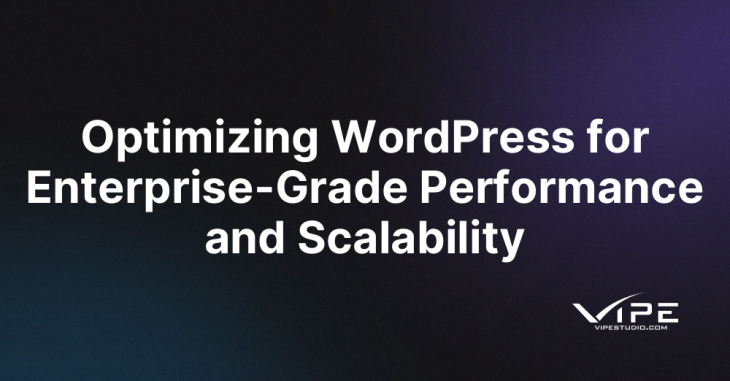Optimizing WordPress for Enterprise-Grade Performance and Scalability

READING TIME: MIN
As businesses grow and digital demands increase, ensuring that your WordPress website can handle the scale and performance requirements of an enterprise is crucial. Enterprise-grade WordPress installations often face challenges such as high traffic volumes, complex data management needs, and enhanced security concerns. To ensure your WordPress site can meet these demands, a combination of optimization strategies and best practices is required. This article covers the key areas to focus on for optimizing WordPress for enterprise performance and scalability.
Why WordPress Needs Optimization for Enterprise-Level Sites
While WordPress is a robust and versatile platform, its out-of-the-box performance may not be sufficient for the demands of large enterprises. As your business grows, so does the complexity of your digital infrastructure. Optimizing WordPress is essential for the following reasons:
- Handling High Traffic Volumes: Enterprise websites experience fluctuations in traffic, often leading to slower load times. Without proper optimization, this can result in a poor user experience, which affects conversion rates and overall satisfaction.
- Complex Data Management: Enterprise-level websites often need to handle large volumes of data, such as customer profiles, transactional data, and content management across departments.
- Security and Compliance: Enterprises are prime targets for cyberattacks. Ensuring that your WordPress site is optimized for security is essential to protect sensitive data and comply with regulations like GDPR and CCPA.
Key Areas of Focus for Optimizing Enterprise WordPress Sites
Optimizing WordPress for scalability and performance involves several areas of focus. Here are the top strategies to consider:

1. Implement Caching Solutions
One of the most effective ways to boost your WordPress site’s performance is by implementing caching mechanisms. Caching stores static versions of your site’s content, reducing the need for database queries every time a user visits the page.
For enterprise websites with high traffic, it’s critical to leverage caching at various levels, such as:
- Page Caching: Caching entire web pages for faster loading times.
- Object Caching: Storing complex database queries to reduce the load on your database.
- Browser Caching: Enabling users’ browsers to store certain files so that they don’t need to be reloaded during future visits.
2. Use a Content Delivery Network (CDN)
A Content Delivery Network (CDN) is crucial for enterprises with global audiences. CDNs distribute your site’s static content across multiple servers worldwide, reducing latency by serving content from the server closest to the user’s location.

By implementing a CDN, you ensure that your website loads quickly, regardless of the user’s geographical location. Popular CDN services include Cloudflare, AWS CloudFront, and StackPath.
3. Optimize Your Database
As an enterprise website grows, so does the database. Large WordPress sites can become bogged down with unnecessary data like post revisions, drafts, and spam comments. Regular database optimization ensures your WordPress site can handle the load without performance degradation.
Key database optimization techniques include:

- Cleaning Up Post Revisions: Limiting post revisions to prevent excessive storage use.
- Removing Unused Tables: Deleting orphaned or obsolete database tables from plugins or themes no longer in use.
- Optimizing Database Queries: Using tools like WP-Optimize to optimize your database tables and improve query efficiency.
4. Use a Scalable Hosting Solution
The hosting environment plays a critical role in the performance and scalability of your WordPress site. For enterprise websites, shared hosting is typically insufficient. A scalable hosting solution ensures that your site can handle traffic spikes and scale as your business grows.
Consider using managed WordPress hosting services or cloud hosting platforms like AWS, Google Cloud, or DigitalOcean. These services offer high levels of scalability and reliability, providing the flexibility to expand resources as needed.
5. Minimize and Optimize Code
Excessive, inefficient, or unoptimized code can drastically reduce website performance. Enterprises should focus on minimizing and optimizing the following code elements:

- CSS and JavaScript: Minify and combine CSS and JavaScript files to reduce the number of requests and load times.
- Image Optimization: Compress images to reduce their size without sacrificing quality. Tools like Smush or ShortPixel can automate image optimization.
- Lazy Loading: Implement lazy loading for images and videos to ensure that content is only loaded when it’s visible to the user, improving initial page load time.
Security Considerations for Enterprise WordPress Optimization
As enterprises deal with sensitive data, WordPress optimization goes hand in hand with robust security practices. Protecting your website from cyber threats is critical. Here are some key security measures to consider:
- Regular Updates: Ensure that WordPress, themes, and plugins are always up-to-date to patch any security vulnerabilities.
- Use SSL Encryption: Implement SSL certificates to encrypt data exchanged between the server and the user, ensuring secure communication.
- Limit Login Attempts: Use plugins like Wordfence to limit login attempts and protect against brute force attacks.
Scalability Best Practices for WordPress Sites
As your enterprise grows, scalability becomes crucial. To ensure your WordPress site can grow alongside your business, follow these best practices:
- Decouple the Front-End with Headless WordPress: Headless WordPress allows you to scale the back-end independently of the front-end, making it easier to integrate with other systems and provide faster user experiences.
- Use Horizontal Scaling: Horizontal scaling allows you to distribute traffic across multiple servers, ensuring that no single server bears the brunt of high traffic spikes.
- Implement Multi-Site Networks: For enterprises with multiple brands or regional websites, WordPress Multisite allows you to manage several websites from a single WordPress installation, saving time and resources.
Conclusion: Achieving Optimal Performance with WordPress for Enterprises
Optimizing WordPress for enterprise-scale performance and scalability requires a strategic approach. By focusing on caching, database optimization, secure hosting, and scalable infrastructure, enterprises can ensure that their WordPress site performs reliably and efficiently, even under heavy traffic.

If you’re ready to take your enterprise WordPress site to the next level, contact Vipe Studio to discuss how we can help you optimize your WordPress site for maximum performance, security, and scalability.

